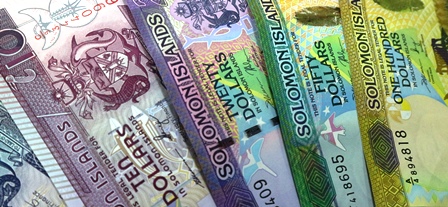CURRENCY
By law the Central Bank of Solomon Islands (CBSI) shall issue, regulate and manage the currency of Solomon Islands. Which means only the Central Bank has the power to issue currency.
Currency History
Solomon Islands Monetary Authority (SIMA) as it was known back than before the name was changed to CBSI, was first to launched the country’s currency consisting of $10, $5, $2 banknotes and $1.00, 20c, 10c, 5c, 2c, 1c coins. See timeline below.
(1977- 1987): We introduced our first notes and coins in 1977. A new $20 note was issued in 1980.
(1987 – 1997): A new $50 note and 50 cents coin were introduced into circulation. The theme for the new $50 note was ‘flora and fauna.’ The theme for the new $50 note was ‘flora and fauna.’ To celebrate the first 10 years of active circulation, the Central Bank removed the effigy of the Queen and replaced it with the government’s coat of arms on all its banknotes.
(1997 – 2007): A new $100 banknote (with hologram) was introduced. The banknote was launched to celebrate achievements in the coconut industry, which sustained the 80% rural dwellers who relied on copra as a source of income to pay for school fees and other necessities. Copra continues to bring in foreign exchange to the country’s reserves. This period was indeed a time of reckoning.
(2007 – 2017): The bank commenced reforms to the security and design specifications on our notes beginning with the $50 note in 2013, followed by the $100 in 2015 and the $20 and $10 notes in 2017. The bank was working on a new $5 note, which will be on polymer substrate to be issued in the first quarter of 2019. Again, the bank intend to improve the durability of our notes by reintroducing polymer substrate in our circulating notes. Within the last 10 years Central Bank also introduce lighter and smaller coins.
(2017-2018): The bank issued a commemorative $40 note and $2 colored coin to commemorate and celebrate the country’s 40th anniversary since independence.
(2019): The bank launched its new $5 polymer substrate note which was issued in the first quarter of 2019.
Our banknotes have captured in their designs specifications of some of the important characteristics of our young nation.
Banks Role in Currency Management
Subject to the law, under the CBSI ACT 2012, s18 – s25 The Central Bank is the only institution that can issue banknotes and coins. Currency issued by the Central Bank shall be legal tender in Solomon Islands. By this law, the bank has the mandate and role over the,
- Issuance of currency
- Exchange of currency
- Verification and confirmation of unfit currency
- Redemption of currency
- Currency reserve inventory and issue plan
- And counterfeit currency
CBSI Banknotes
 The Central Bank has sole authority for the issue and distribution of SI notes and coins, which are legal tender in Solomon Islands. The Solomon Islands Banknotes is divided into six denominations: $100, $50, $40, $20, $10, $5.
The Central Bank has sole authority for the issue and distribution of SI notes and coins, which are legal tender in Solomon Islands. The Solomon Islands Banknotes is divided into six denominations: $100, $50, $40, $20, $10, $5.
» Banknotes in CirculationCounterfeit Prevention & Security
Counterfeit notes are a threat to the circulation of our genuine currency. Counterfeiting is illegal in Solomon Islands, according to the CBSI Act 2012, section 24, 25 (2) any person caught and guilty of this offence is liable on conviction to a fine not exceeding fifty thousand penalty units or imprisonment of seven years.
Every notes comes with security features that act as a deterrent and safeguard to minimize the risk of counterfeiting. The Central Bank wants to encourage the public to be aware of the security features and be able to distinguish between genuine and fake notes.
Security Features of a Genuine Banknote:
- Woven silver thread line
- Watermark depicting eagles head (new series), it is visible from both sides of the banknotes
- Silver dual image hologram on $50.00 and $100.00
- Color and texture of banknotes, colour should stand out and should be rough when feel with hands
- Look for electrotype (word CBSI) at the background when hold against light
- Block invisible inks on the surface of the notes
- Red fluorescent serial numbering
- Sizes and edges are even
- Do a simple color test by rubbing against a white paper, the color of the note will be noticed on the paper.
How to Detect a Counterfeit Banknote:
- Do not rely on one security feature
- Always look out for as many security features as possible
- Always take your time to check your money, where possible.
Best Features to Look Out For:
- Paper and feel (crispy texture or feel to the notes)
- Color and design
- Micro print
- Silver and edges
- Security thread (silver clear text security thread
- Watermark (Eagles head or flying Eagle)
- Silver hologram
- Simple color test
What Should I Do If I Have A Counterfeited Banknote
If you suspect that a note is counterfeit, we suggest you follow the guideline below:
- If possible, try to hold onto the banknotes and do not re-circulate it
- Get in touch with the CBSI or Police
- Note the description of the person or compliance
- If you hand over the banknote to the police, always make sure to get a receipt, if it is a counterfeit, you will not get it back, if the banknote turn out to be real it will be returned to you.
